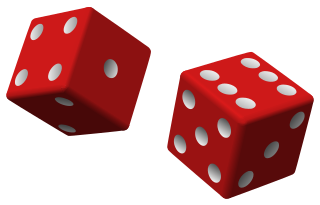A pseudorandom number generator (PRNG), also known as a deterministic random bit generator (DRBG), is an algorithm for generating a sequence of numbers whose properties approximate the properties of sequences of random numbers. The PRNG-generated sequence is not truly random, because it is completely determined by an initial value, called the PRNG's seed. Although sequences that are closer to truly random can be generated using hardware random number generators, pseudorandom number generators are important in practice for their speed in number generation and their reproducibility.

A linear congruential generator (LCG) is an algorithm that yields a sequence of pseudo-randomized numbers calculated with a discontinuous piecewise linear equation. The method represents one of the oldest and best-known pseudorandom number generator algorithms. The theory behind them is relatively easy to understand, and they are easily implemented and fast, especially on computer hardware which can provide modular arithmetic by storage-bit truncation.
The Mersenne Twister is a general-purpose pseudorandom number generator (PRNG) developed in 1997 by Makoto Matsumoto and Takuji Nishimura. Its name derives from the fact that its period length is chosen to be a Mersenne prime.
A Lagged Fibonacci generator is an example of a pseudorandom number generator. This class of random number generator is aimed at being an improvement on the 'standard' linear congruential generator. These are based on a generalisation of the Fibonacci sequence.

A stream cipher is a symmetric key cipher where plaintext digits are combined with a pseudorandom cipher digit stream (keystream). In a stream cipher, each plaintext digit is encrypted one at a time with the corresponding digit of the keystream, to give a digit of the ciphertext stream. Since encryption of each digit is dependent on the current state of the cipher, it is also known as state cipher. In practice, a digit is typically a bit and the combining operation is an exclusive-or (XOR).
In computing, a linear-feedback shift register (LFSR) is a shift register whose input bit is a linear function of its previous state.

RANDU is a linear congruential pseudorandom number generator (LCG) of the Park–Miller type, which was used primarily in the 1960s and 1970s. It is defined by the recurrence:
In finite field theory, a branch of mathematics, a primitive polynomial is the minimal polynomial of a primitive element of the finite field GF(pm). This means that a polynomial F(X) of degree m with coefficients in GF(p) = Z/pZ is a primitive polynomial if it has a root α in GF(pm) such that {0, 1, α, α2, α3, ..., αpm−2} is the entire field GF(pm). This implies that α is a primitive -root of unity in GF(pm).
George Marsaglia was an American mathematician and computer scientist. He is best known for creating the diehard tests, a suite of software for measuring statistical randomness.

Random number generation is a process by which, often by means of a random number generator (RNG), a sequence of numbers or symbols that cannot be reasonably predicted better than by random chance is generated. This means that the particular outcome sequence will contain some patterns detectable in hindsight but unpredictable to foresight. True random number generators can be hardware random-number generators (HRNGS) that generate random numbers, wherein each generation is a function of the current value of a physical environment's attribute that is constantly changing in a manner that is practically impossible to model. This would be in contrast to so-called "random number generations" done by pseudorandom number generators (PRNGs) that generate numbers that only look random but are in fact pre-determined—these generations can be reproduced simply by knowing the state of the PRNG.

The ziggurat algorithm is an algorithm for pseudo-random number sampling. Belonging to the class of rejection sampling algorithms, it relies on an underlying source of uniformly-distributed random numbers, typically from a pseudo-random number generator, as well as precomputed tables. The algorithm is used to generate values from a monotonically decreasing probability distribution. It can also be applied to symmetric unimodal distributions, such as the normal distribution, by choosing a value from one half of the distribution and then randomly choosing which half the value is considered to have been drawn from. It was developed by George Marsaglia and others in the 1960s.
A randomness test, in data evaluation, is a test used to analyze the distribution of a set of data to see if it can be described as random (patternless). In stochastic modeling, as in some computer simulations, the hoped-for randomness of potential input data can be verified, by a formal test for randomness, to show that the data are valid for use in simulation runs. In some cases, data reveals an obvious non-random pattern, as with so-called "runs in the data". If a selected set of data fails the tests, then parameters can be changed or other randomized data can be used which does pass the tests for randomness.
In computer science, multiply-with-carry (MWC) is a method invented by George Marsaglia for generating sequences of random integers based on an initial set from two to many thousands of randomly chosen seed values. The main advantages of the MWC method are that it invokes simple computer integer arithmetic and leads to very fast generation of sequences of random numbers with immense periods, ranging from around to .
The Lehmer random number generator, sometimes also referred to as the Park–Miller random number generator, is a type of linear congruential generator (LCG) that operates in multiplicative group of integers modulo n. The general formula is

Xorshift random number generators, also called shift-register generators, are a class of pseudorandom number generators that were invented by George Marsaglia. They are a subset of linear-feedback shift registers (LFSRs) which allow a particularly efficient implementation in software without the excessive use of sparse polynomials. They generate the next number in their sequence by repeatedly taking the exclusive or of a number with a bit-shifted version of itself. This makes execution extremely efficient on modern computer architectures, but it does not benefit efficiency in a hardware implementation. Like all LFSRs, the parameters have to be chosen very carefully in order to achieve a long period.
In sequence design, a Feedback with Carry Shift Register is the arithmetic or with carry analog of a linear-feedback shift register (LFSR). If is an integer, then an N-ary FCSR of length is a finite state device with a state consisting of a vector of elements in and an integer . The state change operation is determined by a set of coefficients and is defined as follows: compute . Express s as with in . Then the new state is . By iterating the state change an FCSR generates an infinite, eventually periodic sequence of numbers in .
A permuted congruential generator (PCG) is a pseudorandom number generation algorithm developed in 2014 which applies an output permutation function to improve the statistical properties of a modulo-2n linear congruential generator. It achieves excellent statistical performance with small and fast code, and small state size.
The ACORN or ″Additive Congruential Random Number″ generators are a robust family of PRNGs for sequences of uniformly distributed pseudo-random numbers, introduced in 1989 and still valid in 2019, thirty years later.
In computational number theory, Marsaglia's theorem connects modular arithmetic and analytic geometry to describe the flaws with the pseudorandom numbers resulting from a linear congruential generator. As a direct consequence, it is now widely considered that linear congruential generators are weak for the purpose of generating random numbers. Particularly, it is inadvisable to use them for simulations with the Monte Carlo method or in cryptographic settings, such as issuing a public key certificate, unless specific numerical requirements are satisfied. Poorly chosen values for the modulus and multiplier in a Lehmer random number generator will lead to a short period for the sequence of random numbers. Marsaglia's result may be further extended to a mixed linear congruential generator.





